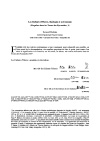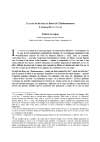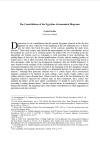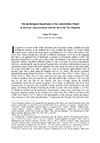Constellations
« Les Enfants d’Horus, thĂ©ologie et astronomie »
ENiM 1, 2008, p. 7-14.
 Une enquête menée sur les Enfants d'Horus (Hâpy, Douamoutef, Imséti et Qébehsénouf ) dans les Textes des Pyramides permet de mettre en relief leur véritable identité théologique, leurs fonctions essentielles, ainsi que les correspondants que les Égyptiens leur avaient attribués dans le ciel nocturne, au sein des constellations que nous nommons Orion et la Grande Ourse.
Une enquête menée sur les Enfants d'Horus (Hâpy, Douamoutef, Imséti et Qébehsénouf ) dans les Textes des Pyramides permet de mettre en relief leur véritable identité théologique, leurs fonctions essentielles, ainsi que les correspondants que les Égyptiens leur avaient attribués dans le ciel nocturne, au sein des constellations que nous nommons Orion et la Grande Ourse.
 A synthetic study of the Sons of Horus (Hâpy, Duamutef, Imseti and Qebehsenuf) in the Pyramid Texts is proposed, showing their genuine theological nature, their main functions, and the celestial correspondants the Egyptian gave them in the night sky, inside the constellations we call Orion and Great Bear (Ursa Major).
A synthetic study of the Sons of Horus (Hâpy, Duamutef, Imseti and Qebehsenuf) in the Pyramid Texts is proposed, showing their genuine theological nature, their main functions, and the celestial correspondants the Egyptian gave them in the night sky, inside the constellations we call Orion and Great Bear (Ursa Major).
 Consulter cet article (68229) -
Consulter cet article (68229) -  Télécharger cet article au format pdf (36030)
Télécharger cet article au format pdf (36030)
« Le cycle du ba dans le Rituel de l’Embaumement P. Boulaq III, 8, 12-8, 16 »
ENiM 2, 2009, p. 9-23.
 L’analyse de quelques passages du Rituel de l’Embaumement (P. Boulaq III) permet de reconstituer le cycle du ba dans un contexte spécifique de momification et de comprendre la logique des traditions sur lesquelles il se fonde, résultant de l’observation minutieuse de la nature.
L’analyse de quelques passages du Rituel de l’Embaumement (P. Boulaq III) permet de reconstituer le cycle du ba dans un contexte spécifique de momification et de comprendre la logique des traditions sur lesquelles il se fonde, résultant de l’observation minutieuse de la nature.
 The analysis of some passages of the Embalming Ritual (P. Boulaq III) allows to reconstitute the cycle of the ba in a specific context of mummification and to understand the logic of the traditions on which it is based, resulting from the meticulous observation of the nature.
The analysis of some passages of the Embalming Ritual (P. Boulaq III) allows to reconstitute the cycle of the ba in a specific context of mummification and to understand the logic of the traditions on which it is based, resulting from the meticulous observation of the nature.
 Consulter cet article (89472) -
Consulter cet article (89472) -  Télécharger cet article au format pdf (36928)
Télécharger cet article au format pdf (36928)
« The Constellations of the Egyptian Astronomical Diagrams »
ENiM 12, 2019, p. 137-180.
 La représentation de la manière dont les Anciens Égyptiens voyaient le ciel transparaît dans les tableaux astronomiques figurés dans des tombeaux, des temples funéraires, des clepsydres et des cercueils. Les dessins des constellations étaient un élément important de ce catalogue – qui consigne des informations aussi bien écrites qu’iconiques – des phénomènes célestes. Ces dessins se présentent en deux groupes, sur les panneaux boréaux et méridionaux des tableaux astronomiques. Il existait deux traditions différentes se rapportant aux constellations septentrionales représentées par des tableaux astronomiques dans les tombeaux de Senenmout et de Séthi Ier. À partir de l’analyse de l’emplacement des figurations de constellations se trouvant dans ces documents et de la vérification approfondie de la vaste collection des sources concernant le sujet – fondé sur le principe des ressemblances iconiques et à l’aide du logiciel planetarium –, cet essai identifie les motifs stellaires d’où proviennent les constellations de l’Ancienne Égypte.
La représentation de la manière dont les Anciens Égyptiens voyaient le ciel transparaît dans les tableaux astronomiques figurés dans des tombeaux, des temples funéraires, des clepsydres et des cercueils. Les dessins des constellations étaient un élément important de ce catalogue – qui consigne des informations aussi bien écrites qu’iconiques – des phénomènes célestes. Ces dessins se présentent en deux groupes, sur les panneaux boréaux et méridionaux des tableaux astronomiques. Il existait deux traditions différentes se rapportant aux constellations septentrionales représentées par des tableaux astronomiques dans les tombeaux de Senenmout et de Séthi Ier. À partir de l’analyse de l’emplacement des figurations de constellations se trouvant dans ces documents et de la vérification approfondie de la vaste collection des sources concernant le sujet – fondé sur le principe des ressemblances iconiques et à l’aide du logiciel planetarium –, cet essai identifie les motifs stellaires d’où proviennent les constellations de l’Ancienne Égypte.
 Representations of how the ancient Egyptians saw the sky have come down to us in the form of astronomical diagrams that are known from tombs, memorial temples, water clocks, and coffins. An emphatic element of these catalogues of celestial phenomena, comprising both textual and visual information, was the drawings of constellations. They appeared in two groups in the southern and northern panels of the astronomical diagrams. Two different strands of tradition existed about the northern constellations, exemplified by the astronomical diagrams in the tombs of Senenmut and Seti I. Based on the analysis of the arrangement of the constellation figures within these documents, and through the examination of a wide range of relevant sources, the paper – using the principle of visual resemblance and the help of planetarium software – identifies the star patterns in the sky from which the ancient Egyptian constellations were derived.
Representations of how the ancient Egyptians saw the sky have come down to us in the form of astronomical diagrams that are known from tombs, memorial temples, water clocks, and coffins. An emphatic element of these catalogues of celestial phenomena, comprising both textual and visual information, was the drawings of constellations. They appeared in two groups in the southern and northern panels of the astronomical diagrams. Two different strands of tradition existed about the northern constellations, exemplified by the astronomical diagrams in the tombs of Senenmut and Seti I. Based on the analysis of the arrangement of the constellation figures within these documents, and through the examination of a wide range of relevant sources, the paper – using the principle of visual resemblance and the help of planetarium software – identifies the star patterns in the sky from which the ancient Egyptian constellations were derived.
 Consulter cet article (49441) -
Consulter cet article (49441) -  Télécharger cet article au format pdf (22874)
Télécharger cet article au format pdf (22874)
« The mythological importance of the constellation Msḫtjw in mortuary representations until the end of the New Kingdom »
ENiM 13, 2020, p. 1-61.
 Étant une des rares constellations Ă pouvoir ĂŞtre identifiĂ©es avec une certitude raisonnable comme la (Grande) Casserole, une partie de la Grande Ourse, l’astĂ©risme Ă©gyptien de Msḫtjw (la Cuisse du taureau) a reçu une attention particulière dans les Ă©tudes Ă©gyptologiques modernes. Sur certains couvercles de cercueil du Moyen Empire, il apparaĂ®t comme une patte antĂ©rieure du taureau, tandis que, depuis le Nouvel Empire, il est reprĂ©sentĂ© soit comme un taureau, soit comme un taureau avec ou sans membres, surtout dans les tombeaux royaux et ceux des Ă©lites, faisant partie du diagramme qui prĂ©sente les constellations du ciel du nord. Étant donnĂ© que les reprĂ©sentations de Msḫtjw apparaissent dans un environnement qui peut ĂŞtre Ă©troitement associĂ© Ă la sphère mortuaire, on peut poser la question de la relation qu’elles entretenaient avec les rituels et les textes funĂ©raires et, plus gĂ©nĂ©ralement, avec la notion d’au-delĂ . Le but du prĂ©sent article est de retrouver les traces des rĂ©fĂ©rences mythologiques les plus importantes qui renvoient Ă la constellation en question et de tenter de souligner sa signification comme partie d’un ensemble ayant jouĂ© un rĂ´le clĂ© dans la rĂ©surrection du dĂ©funt osirianisĂ©. Puisque toutes les sources prototypiques actuellement connues reprĂ©sentant Msḫtjw proviennent du Moyen et du Nouvel Empire, avec quelques variantes dĂ©rivĂ©es des pĂ©riodes tardives, il a Ă©tĂ© jugĂ© opportun de traiter principalement ces variantes au cours de cette Ă©tude. En consĂ©quence, l’accent a Ă©tĂ© mis sur les sources textuelles de l’Ancien au Nouvel Empire, en tenant compte des allusions postĂ©rieures, qui complètent les sources les plus anciennes.
Étant une des rares constellations Ă pouvoir ĂŞtre identifiĂ©es avec une certitude raisonnable comme la (Grande) Casserole, une partie de la Grande Ourse, l’astĂ©risme Ă©gyptien de Msḫtjw (la Cuisse du taureau) a reçu une attention particulière dans les Ă©tudes Ă©gyptologiques modernes. Sur certains couvercles de cercueil du Moyen Empire, il apparaĂ®t comme une patte antĂ©rieure du taureau, tandis que, depuis le Nouvel Empire, il est reprĂ©sentĂ© soit comme un taureau, soit comme un taureau avec ou sans membres, surtout dans les tombeaux royaux et ceux des Ă©lites, faisant partie du diagramme qui prĂ©sente les constellations du ciel du nord. Étant donnĂ© que les reprĂ©sentations de Msḫtjw apparaissent dans un environnement qui peut ĂŞtre Ă©troitement associĂ© Ă la sphère mortuaire, on peut poser la question de la relation qu’elles entretenaient avec les rituels et les textes funĂ©raires et, plus gĂ©nĂ©ralement, avec la notion d’au-delĂ . Le but du prĂ©sent article est de retrouver les traces des rĂ©fĂ©rences mythologiques les plus importantes qui renvoient Ă la constellation en question et de tenter de souligner sa signification comme partie d’un ensemble ayant jouĂ© un rĂ´le clĂ© dans la rĂ©surrection du dĂ©funt osirianisĂ©. Puisque toutes les sources prototypiques actuellement connues reprĂ©sentant Msḫtjw proviennent du Moyen et du Nouvel Empire, avec quelques variantes dĂ©rivĂ©es des pĂ©riodes tardives, il a Ă©tĂ© jugĂ© opportun de traiter principalement ces variantes au cours de cette Ă©tude. En consĂ©quence, l’accent a Ă©tĂ© mis sur les sources textuelles de l’Ancien au Nouvel Empire, en tenant compte des allusions postĂ©rieures, qui complètent les sources les plus anciennes.
 The ancient Egyptian constellation of Msḫtjw, or the Bull’s Foreleg, has obtained a unique position in modern Egytological studies as being one of the rare asterisms which can be identified with considerable certainty as our modern day Big Dipper, a part of Ursa Major. On certain Middle Kingdom coffin lids it appears as a bull’s foreleg, while from the New Kingdom on it is represented either in the from of a bull, or as a bull with or without rudimentary limbs, mostly in elite and royal tombs as being part of the diagram presenting the constellations of the northern sky. Since these depictions of Msḫtjw appear in an environment intimately related to the mortuary sphere, the question arises as to what relationship it possibly had with mortuary rituals and liturature, and – in a broader sense – with the notion of the Afterlife. The present paper endeavours to trace the most important mythological references pertaining to the examined constellation, and thereby attempts to pinpoint its significance as part of a presumed source narrative, which played a key role in the apotheosis of the Osirian deceased. Since all the presently known prototypal sources depicting Msḫtjw stem from the Middle and the New Kingdoms with only derived variants from the later periods, it was considered appropriate to discuss mainly these earlier variants during the course of this study. Accordingly, greater emphasis was put on textual sources spanning from the Old to the New Kingdom, supplied with the important echoes of mythico-religious references of later times, which tangibly justify and supplement the earliest attestable narratives.
The ancient Egyptian constellation of Msḫtjw, or the Bull’s Foreleg, has obtained a unique position in modern Egytological studies as being one of the rare asterisms which can be identified with considerable certainty as our modern day Big Dipper, a part of Ursa Major. On certain Middle Kingdom coffin lids it appears as a bull’s foreleg, while from the New Kingdom on it is represented either in the from of a bull, or as a bull with or without rudimentary limbs, mostly in elite and royal tombs as being part of the diagram presenting the constellations of the northern sky. Since these depictions of Msḫtjw appear in an environment intimately related to the mortuary sphere, the question arises as to what relationship it possibly had with mortuary rituals and liturature, and – in a broader sense – with the notion of the Afterlife. The present paper endeavours to trace the most important mythological references pertaining to the examined constellation, and thereby attempts to pinpoint its significance as part of a presumed source narrative, which played a key role in the apotheosis of the Osirian deceased. Since all the presently known prototypal sources depicting Msḫtjw stem from the Middle and the New Kingdoms with only derived variants from the later periods, it was considered appropriate to discuss mainly these earlier variants during the course of this study. Accordingly, greater emphasis was put on textual sources spanning from the Old to the New Kingdom, supplied with the important echoes of mythico-religious references of later times, which tangibly justify and supplement the earliest attestable narratives.
 Consulter cet article (47053) -
Consulter cet article (47053) -  Télécharger cet article au format pdf (22074)
Télécharger cet article au format pdf (22074)
ENiM 18 - 2025
8 article(s) - 8 octobre 2025.
ENiM 1 à 18 (2008-2025) : 227 articles
5 160 232 téléchargements
10 320 536 consulations.
Index des auteurs

Mots clés

Derniers articles : 
CENiM - Mise en ligne des volumes Ă©puisĂ©s : 
 Anne-Sophie von BOMHARD DĂ©cans Ă©gyptiens, CENiM 23, Montpellier, 2020 — (2020)
Anne-Sophie von BOMHARD DĂ©cans Ă©gyptiens, CENiM 23, Montpellier, 2020 — (2020) 
 Jean-Claude Grenier L'Osiris ANTINOOS, CENiM 1, Montpellier, 2008 — (26 dĂ©cembre 2008)
Jean-Claude Grenier L'Osiris ANTINOOS, CENiM 1, Montpellier, 2008 — (26 dĂ©cembre 2008) 
TDENiM - Mise en ligne des volumes Ă©puisĂ©s : 
 Twitter
Twitter 4126701 visites - 13279 visite(s) aujourd’hui - 196 connecté(s)
© ENiM - Une revue d’égyptologie sur internet
Équipe Égypte Nilotique et Méditerranéenne - UMR 5140 - « Archéologie des Sociétés Méditerranéennes » (Cnrs) - Université Paul Valéry - Montpellier III

























 Contact
Contact
 Abonnez-vous !
Abonnez-vous ! Équipe Égypte Nilotique et Méditerranéenne
Équipe Égypte Nilotique et Méditerranéenne UMR 5140 « Archéologie des Sociétés Méditerranéennes » (Cnrs)
UMR 5140 « Archéologie des Sociétés Méditerranéennes » (Cnrs) Université Paul Valéry - Montpellier III
Université Paul Valéry - Montpellier III